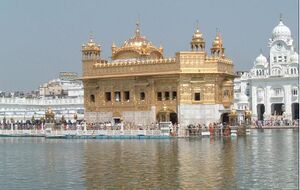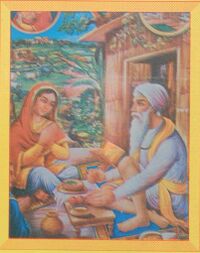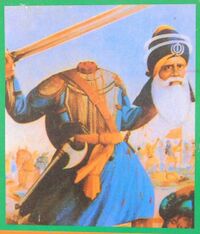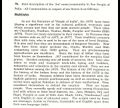Amritsar
| Author:Laxman Burdak, IFS (Retd.) |
Amritsar (Punjabi: ਅੰਮ੍ਰਿਤਸਰ, Hindi: अमृतसर), meaning: The Pool of the Nectar of Immortality, is the administrative headquarter of the Amritsar District in Punjab, India.
Contents
Tahsils in Amritsar

Note - Khadur Sahib, Patti and Tarn Taran tahsils which were earlier part of Amritsar district, are now part of newly formed district of Tarn Taran, which was formed in 2006.
History
The 2001 Indian census reported the population of the city to be over 1,500,000 and that of the entire district to number just over 3,695,077. Amritsar city is one of the major cities of the Punjab state. Under instructions from Guru Amar Das, this city was founded by Guru Ram Das in 1574, on land bought by him for 700 rupees from the owners of the village of Tung.
Amritsar is located in the northwest part of India in the State of Punjab, 32 miles (51 km) east of Lahore, Pakistan. Some have taken the name Amritsar to derive Amŗit-sarovar meaning "The Pool of the Nectar of Immortality" though -sar, "Natural pool" does not derive from sarovar, "Artificial tank or body of water".
It is home to the Harimandir Sahib, also known as the Golden Temple, and is the spiritual and cultural centre of the Sikh religion.
अमृतसर
विजयेन्द्र कुमार माथुर[1] ने लेख किया है ...अमृतसर (AS, p.33): यह सिखों का महान तीर्थ है. किंवदन्ती है, कि रामायण काल में अमृतसर के स्थान पर एक घना वन था, जहाँ एक सरोवर भी स्थित था। श्रीरामचन्द्र के पुत्र लव और कुश आखेट के लिए एक बार यहाँ पर आकर सरोवर के तीर पर कुछ समय के लिए ठहरे थे। ऐतिहासिक समय में सिक्खों के आदिगुरु नानक ने भी इस स्थान के प्राकृतिक सौंन्दर्य से आकृष्ट होकर यहाँ कुछ देर के लिए एक वृक्ष के नीचे विश्राम तथा ध्यान किया था। यह वृक्ष वर्तमान सरोवर के निकट आज भी दिखाया जाता है। तीसरे गुरु रामदास ने नानकदेव का इस स्थान से सम्बन्ध होने के कारण यहाँ एक मन्दिर बनवाने का विचार किया। 1564 ई. में चौथे गुरु रामदास ने वर्तमान अमृतसर नगर की नींव डाली और स्वयं भी यहाँ पर आकर रहने लगे। इस समय इस नगर को रामदासपुर या चक-रामदास कहते थे। 1577 में मुग़ल सम्राट अकबर ने रामदास को 500 बीघा भूमि नगर को बसाने के लिए दी, जो उन्होंने तुंग के ज़मीदारों को 700 रुपये अकबरी देकर ख़रीदी। कहा जाता है, कि सरोवर के पवित्र जल में स्नान करने से एक कौवे के पर श्वेत हो गए थे और कोढ़ी का रोग जाता रहा था। [p.34]: इस दन्तकथा से आकृष्ट होकर सहस्रों लोग यहाँ आने-जाने लगे और नगर की आबादी भी बढ़ने लगी।
1589 में गुरु अर्जुन देव के एक शिष्य शेखमियाँ मीर ने सरोवर के बीच में स्थित वर्तमान स्वर्ण मंदिर की नींव डाली. मंदिर के चारों ओर 4 दरवाजों का प्रबंध किया गया था. यह गुरु नानक के उदार धार्मिक विचारों का प्रतीक समझा गया. मंदिर में गुरु ग्रंथसाहब की, जिसका संग्रह गुरु अर्जुनदेव ने किया था, स्थापना की गई थी. सरोवर को गहरा करवाने और परिवर्धित करवाने का कार्य बाबा बूढ़ा नामक व्यक्ति को सौंपा गया था और इन्हें ही ग्रंथसाहब का प्रथम-ग्रंथी बनाया गया.
1757 में वीर सरदार बाबा दीपसिंह जी ने मुसलमानों के अधिकार से इस मंदिर को छुड़ाया किंतु वे उनके साथ लड़ते हुए वीरगति को प्राप्त हुए. उन्होंने अपने अधकटे सिर को को संभालते हुए अनेक शत्रुओं को तलवार के घाट उतारा. उनकी दुधारी तलवार मंदिर के संग्रहालय में सुरक्षित है. स्वर्ण मंदिर के निकट बाबा अटलराय का गुरुद्वारा है. ये छटे गुरु हरगोविंद के पुत्र थे और 9 वर्ष की आयु में ही संत समझे जाने लगे थे. उन्होंने इतनी छोटी सी उम्र में एक मृत शिष्य को जीवनदान देने में अपने प्राण होम दिए थे. कहा जाता है कि गुरुद्वारे की 9 मंजिलें इस बालक की आयु की प्रतीक हैं. पंजाब केसरी महाराज रणजीतसिंह ने स्वर्ण मंदिर को एक बहुमूल्य पटमंडप दान में दिया जो संग्रहालय में है. वास्तव में रणजीत सिंह की सहायता से ही मंदिर अपने वर्तमान रूप को प्राप्त कर सका. इसके शिखर पर सुवर्ण-पत्र चढवाने का श्रेय भी उन्हें ही दिया जाता है. 1919 की जलियांवाला बाग की घटना के कारण अमृतसर का नाम भारत की स्वतंत्रता के इतिहास में भी चिरस्थाई हो गया है.
अमृतसर परिचय
अमृतसर शहर, ज़िले का प्रशासनिक मुख्यालय, पंजाब राज्य, पश्चिमोत्तर भारत में स्थित है। अमृतसर पाकिस्तानी सीमा पर, पंजाब का सबसे बड़ा नगर है। यह गुरु रामदास का डेरा हुआ करता था। अमृतसर अनेक त्रासदियों और दर्दनाक घटनाओं का गवाह रहा है। भारतीय स्वतंत्रता संग्राम का सबसे बड़ा नरसंहार अमृतसर के जलियांवाला बाग़ में ही हुआ था। इसके बाद भारत-पाकिस्तान के बीच जो बंटवारा हुआ उस समय भी अमृतसर में बड़ा हत्याकांड हुआ।
यहीं नहीं अफ़ग़ान और मुग़ल शासकों ने इसके ऊपर अनेक आक्रमण किए और इसको बर्बाद कर दिया। इसके बावजूद सिक्खों ने अपने दृढ संकल्प और मज़बूत इच्छाशक्ति से दोबारा इसको बसाया। हालांकि अमृतसर में समय के साथ काफ़ी बदलाव आए हैं लेकिन आज भी अमृसतर की गरिमा बरकरार है।
स्थापना: सीमा से लगभग 50 किमी दूर स्थित अमृतसर एक प्रमुख व्यापारिक व सांस्कृतिक केंद्र है। 1577 में सिक्खों के चौथे गुरु रामदास ने अमृत सारस नामक एक पवित्र सरोवर, जिसके नाम पर इस शहर का नामकरण हुआ, के किनारे अमृतसर की स्थापना की थी। इस तालाब के ठीक मध्य में टापू पर एक मंदिर बनाया गया था, जिसके तांबे के गुंबद को बाद में स्वर्ण-पतरों से मढ़ दिया गया, इस मंदिर का नाम हरमंदिर साहब या स्वर्ण मंदिर रखा गया। अब अमृतसर सिक्ख धर्म का केंद्र बन गया है। उभरती हुई सिक्ख शक्ति के केंद्र के साथ-साथ यह शहर व्यापार के क्षेत्र में भी महत्त्वपूर्ण बनता गया।
इतिहास: 1849 में अमृतसर को ब्रिटिश भारत में मिला दिया गया। 13 अप्रैल 1919 को शहर के जिस जलियांवाला बाग़ में एक राजनीतिक सभा पर ब्रिटिश सेना ने अंधाधुंध गोलियां चलाकर 379 लोगों की हत्या कर दी थी तथा इससे भी अधिक लोगों को घायल कर दिया था, उसे अब राष्ट्रीय स्मारक बना दिया गया है। 1984 में अमृतसर में एक और हिंसक राजनीतिक संघर्ष हुआ, जब स्वर्ण मंदिर में मोर्चाबंद सैकड़ों सिक्ख अलगाववादियों पर भारतीय सेना ने हमला किया। परस्पर विरोधी सूत्रों के अनुसार, इस संघर्ष में 450 से 1,200 लोग मारे गये थे।
संदर्भ: भारतकोश-अमृतसर
Rambagh Amritsar
Gobindgarh Fort, Punjab
Introducing Gobindgarh Fort. Beginnings of fort were a small mud brick one built by the Dhillon Bangi Misl in 1761 ( this misl conquered and ruled most of Western Punjab until their territories were incorporated into Ranjit Singh's Empire ). The Fort was rebuilt, enlarged and modernised ny Ranjit Singh. It was where Ranjit kept the famous Koh-i-noor, the Zamzama ( the biggest cannon of its day ) and where the treaty with the British in 1809 was signed whereby the Brits acknowledged the borders of the Sikh Empire as being up to the Sutlej. It is also the location where General Dyer was encamped prior to his carrying out the Jallianwala Bagh Massacre.
From outside and within Gobindgarh Fort ( huge in size and with the walls built of Nirankari bricks typical of the Sikh Empire period ). The fort was also where Ranjit's French and European officers such as Court, Ventura, Allard, Avitabile etc trained his soldiery in modern artillery. However, this was post 1822 by which time Ranjit had already made all his conquests ( without the assistance of any Europeans ).
Jat clans in Amritsar
Jat Sikh Clans and Their Population in Selective Districts of Punjab Handbooks [2] [3] [4] prepared by British military officers for the recruitment of Sikhs into the British Indian Army contain information on the location of Jat clans and their respective population in various districts of Punjab. Therefore, this section (basically based on these documents) presents various Jat clans and their respective population projected by B S Dhillon. [5]
- Sandhu (67,158): This is probably the strongest clan of the district and holds 121 villages [7]. Their strongest concentration is in the south-west corner of Tarn-Taran area, here, Sandhus hold 32 villages [5].
- Gill (48,210): This clan holds 142 villages [6] in total and specifically its large concentration is in the Tarn Taran area where it holds about 25 villages.
- Dhillon (44,202): This clan as per Captain Falcon [7] holds 140 villages in the district. Some of the Dhillons' villages are Kasel, Dhand, Chabal, Kairon, Padri, Gaggobua, Panjwar, Lijan, and Gandiwind.
- Randhawa (42,480): This clan owns 116 villages [8] and its main strength is in along the Batala border and around Mahta village in the area close to the Amritsar city.
- Aulak (17,841): It is mostly to be found in the area around the town of Ajnala and around the village of Shabazpur in Tarn-Tarn sub-district where the clan owns a cluster of 9 villages.
- Sidhu (26,739): This clan around Atari and Bhakna villages holds 14 villages.
- Chahil (13,527): This clan owns 16 villages near the Sheron Bagha village.
- Bal (17,934): This clan holds a total of 23 villages, for example, Bal Khurad, Bal Kalan, Bal Serai and Jodhe.
- Pannun (14,196): This clan appears to have spread from the Doaba area of the modern Punjab and owns 7 large villages including Naushera and Chaudriwala.
- Bhangu (3,978): This clan holds the large village of Khiala (Khurd and Kalan). The Legendry Mehtab Singh of the Sikhs and I think, General Shubeg Singh of the recent times belonged to this very clan.
- Kang (6,159): This clan holds a cluster of villages in the Tarn-Taran area including Kang, Mal Chak and Kalla.
- Other Jat clans - Bhullar (7,113), Dhaun (22,710), Mahil (7,020), Sadal (7,515), Mann (5,577), Sarai (5,574), Kara, (5,355), Chhina (5,838), Bhat (4,698), Boparae (3,651), Sakuni (3,816), Opal (3,044), Kaler (4,632), Hinjra (4,689), Johal (4,593), Her (3,441), Chimma (3,207), Dhanoa (3,360), Sohal (3,864), Valia (2,868), Soi (2,697), Bajwa (2,874), Athwal (2,067), Bandar (2,316), Bhatti (1,509), Batth (1,653), Bhoi (1,545), Des (1,239), Dhariwal (2,640), Ghumman (372), Garaia (1,203), Hundal (963), Jawara (1,953), Khara (2,025), Jand (1150) , Khera (1,698), Nijjar (2,223), Ojla (2,583), Rai (2,364), Sagwan (1,503), Sansi (2,046), Sumra (1,038), Virk (2,037), and Varaich (2,070).[9]
Muslim Jat clans in Amritsar District
According to 1911 census, the following were the principal Muslim Jat clans in Amritsar District [10]:
Aulakh (674), Bajwa (377), Bal (51), Bhangu (37), Bhullar (61), Chahal (91), Chadhar (166), Chhina (739), Cheema (137), Deo (237), Dhariwal (348), Dhillon (2,298), Ghumman (477), Gill (4,346), Goraya (412), Heer (74), Hanjra (142), Hundal (230), Kahlon (390), Kang (97), Mahil (38), Maan (95), Pannun (91), Randhawa (2,661), Sarai (171), Sidhu (879), Sandhu (2,054), Sohal (218), Samra (53), Virk (325) and, Waraich (492).
External Links
Gallery
Ram Bagh Palace, Amritsar or Ram Bagh Mahal, was the palace of Maharaja Ranjit Singh, founder of Sikh Jat Empire in Punjab, India. It was used as summer palace by Maharaja Ranjit Singh.
Attari Samadhan, Amritsar. Memorial of Sardar Sham Singh Attariwala, General of Lion of Punjab Maharaja Ranjit Singh Sandhawalia of Lahore Army.
Summer Palace, Amritsar - Built by Lion of Punjab Maharaja Ranjit Singh Sandhawalia. Source - Jat Kshatriya Culture
References
- ↑ Aitihasik Sthanavali by Vijayendra Kumar Mathur, p.33-34
- ↑ Barstow, A.E. (Major), The Sikhs: An Ethnology, reprinted by B.R. Publishing Corporation, Delhi, India, 1985, pp. 105-135.
- ↑ Bingley, A.H. (Captain), Handbooks for the Indian Army: Sikhs, compiled under the orders of the Government of India, Printed at the Government Central Printing Office, Simla, India, 1899, pp. 29-37.
- ↑ Falcon, R.W. (Captain), Handbook on Sikhs for the Use of Regimental Officers, Printed at the Pioneer Press, Allahabad, India, 1896, pp. 81-103.
- ↑ History and study of the Jats. By Professor B.S Dhillon. ISBN-10: 1895603021 or ISBN-13: 978-1895603026. 123
- ↑ Falcon, R.W. (Captain), Handbook on Sikhs for the Use of Regimental Officers, Printed at the Pioneer Press, Allahabad, India, 1896, pp. 81-103.
- ↑ Falcon, R.W. (Captain), Handbook on Sikhs for the Use of Regimental Officers, Printed at the Pioneer Press, Allahabad, India, 1896, pp. 81-103.
- ↑ Falcon, R.W. (Captain), Handbook on Sikhs for the Use of Regimental Officers, Printed at the Pioneer Press, Allahabad, India, 1896, pp. 81-103.
- ↑ History and study of the Jats. By Professor B.S Dhillon. ISBN-10: 1895603021 or ISBN-13: 978-1895603026. p. 124
- ↑ Census Of India 1911 Volume xiv Punjab Part 2 by Pandit Narikishan Kaul
Back to Jat Villages





























